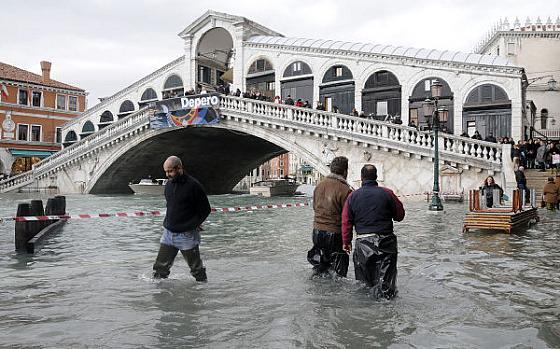EnvironmentEuropeNews
Causalities Reported as Venice Floods at Highest Level in 50 Years

Two people have died as the highest water levels for more than 50 years caused hundreds of millions of euros of possibly irreparable damage in Venice, according to the officials, with another surge expected to cause further flooding.
Severe flooding in Venice that has left much of the Italian city under water is a direct result of climate change, the mayor says.
The highest water levels in the region in more than 50 years would leave “a permanent mark”, Venice Mayor Luigi Brugnaro tweeted.
“Now the government must listen,” he added. “These are the effects of climate change… the costs will be high.”
Flood levels in the lagoon city reached the second-highest level since records began in 1923 as a result of the acqua alta, which hit 1.87 metres (74in) late on Tuesday night amid heavy rain, just short of the record 1.94 metres measured in 1966.
More than 85% of Venice was flooded, authorities said, including the historic St Mark’s basilica. While the water level dropped slightly on Wednesday morning, a further torrent of water, whipped up by high winds, is forecast to sweep in later in the day, reaching a level of 1.60 metres.
St Mark’s Square – one of the lowest parts of the city – was one of the worst hit areas.
St Mark’s Basilica was flooded for the sixth time in 1,200 years, according to church records. Pierpaolo Campostrini, a member of St Mark’s council, said four of those floods had now occurred within the past 20 years.
The mayor said the famous landmark had suffered “grave damage”. The crypt was completely flooded and there are fears of structural damage to the basilica’s columns.
The city of Venice is made up of more than 100 islands inside a lagoon off the north-east coast of Italy.
A number of businesses were affected. Chairs and tables were seen floating outside cafes and restaurants.
In shops, workers tried to move their stock away from the water to prevent any further damage.
Italy’s minister of culture, Dario Franceschini, said the government would provide an as-yet unspecified amount of funding to help preserve the Unesco world heritage site.
Venice sits on thousands of wooden piles driven into the mud, but rising sea levels and heavy cruise ship traffic have steadily eaten away at the surrounding marshes and mudbanks, causing the city to gradually sink.
A project to protect the city from flooding has been under way since 2003 but has been hit by soaring costs, scandals and delays.
The so-called Mose project – a series of large barriers or floodgates that would be raised from the seabed to shut off the lagoon in the event of rising sea levels and winter storms – was successfully tested for the first time in 2013.











